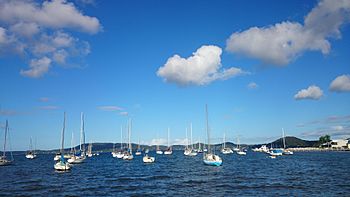Brisbane Water facts for kids
Quick facts for kids Brisbane Water |
|
|---|---|
 |
|
| Country | Australia |
| State | New South Wales |
| Municipality | Central Coast Council |
| Physical characteristics | |
| Main source | Narara Creek Gosford 33°26′00″S 151°19′39″E / 33.43333°S 151.32750°E |
| 2nd source | Coorumbine Creek East Gosford |
| River mouth | Broken Bay Wagstaffe Point – Ettalong Beach 33°31′25″S 151°20′5″E / 33.52361°S 151.33472°E |
| Length | 17.72 km (11.01 mi) |
| Basin features | |
| Basin size | 165 km2 (64 sq mi) |
| Tributaries |
|
Brisbane Water is a wave-dominated barrier estuary located in the Central Coast region, north of Sydney, New South Wales, Australia. Brisbane Water has its origin at the confluence of the Narara and Coorumbine Creeks, to the south–east of Gosford and travels for approximately 18 kilometres (11 mi) in a southerly direction to its mouth at Broken Bay, about 7 kilometres (4.3 mi) from the Tasman Sea, at Barrenjoey Head. A number of towns and suburbs surround the shores of Brisbane Water, including Blackwall, Booker Bay, Davistown, Empire Bay, Erina, Ettalong Beach, Gosford, Green Point, Hardys Bay, Kilcare, Kincumber, Koolewong, Phegans Bay, Point Frederick, Point Clare , Saratoga, Tascott, Wagstaffe, and Woy Woy. Contained within Brisbane Water is St Huberts Island, Rileys Island, Dunmar Island and Pelican Island; and adjoining the estuary is Brisbane Water National Park to the west and Bouddi National Park to the east. Forming part of the same tidal estuary system is a separate but connected basin, the Kincumber Broadwater, lying to the east of Davistown.
The total catchment area of the river is approximately 165 square kilometres (64 sq mi).
The land adjacent to the Brisbane Water was occupied for many thousands of years by Australian Aboriginal peoples, the Darkinjung and Kuringgai, who used the estuary and foreshore areas for cultural purposes.
Brisbane Water was named in 1825 in honour of Sir Thomas Brisbane, a Governor of New South Wales, serving between 1820 and 1825.
History
Brisbane Water is part of the traditional lands of the Darkinjung and Kuringgai aboriginal peoples. Places of significance to Aboriginal people located in the area surrounding Brisbane Water that are listed on the Register of the National Estate include Daleys Point area and Staples Lookout, west of Woy Woy. Initial colonial explorers of the area were assisted by Bungaree, a leader of the Kuringgai tribe who went on to assist Phillip Parker King and Matthew Flinders in the circumnavigation of Australia.
Twentieth century European settlement led to the development of an extensive local ferry network, including one supplying an otherwise isolated orphanage, a commuter service from Gosford to Woy Woy and a third operation dedicated to carrying farm produce. The last commuter ferries between Brisbane Water townships ceased in 1971.

